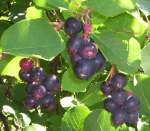
Tasty saskatoon berries ready for the picking!
More fotos
|
Saskatoon berry (serviceberry/juneberry) Amelchanier alnifolia.
Height: up to 15' tall. Size of bushes is managed by pruning out older wood at the base which also ensures vigorous new fruit-producing branches.
Width: Depends how many suckers grow up
Planting: 3-5' apart in-row, 12-14 between row (or more for mechanical harvesters)
Suckers: yes
Pollination: Self-pollinating. Planting multiple varieties increases fruit set marginally but increases fruit seediness.
Disease: Susceptible to woolly elm aphid and fire blight. Usually more of a problem in orchard settings than in home gardens.
Planting: Plant a couple inches deep. Prune tips to promote suckering. After 3 years, prune 1/4 of bush at ground level each year to rejuvenate.
USDA zone:Best in 2-4, may not produce as well in 5 and higher. (warmer zones check your chill hours - NCSU reports hardiness to zone 9 but no guarantee for varieties listed below)
Chill hours: Alberta Saskatoon Berry Manual- minimum chilling period of approximately 3 months (0C / 32-39F) Getchill here
Varieties: All taste good to us! If you are looking into growing them commercially, links are provided below for more research as to which varieties might suit your operation better. We have no recommendations for which variety grows best in any particular region.
More info:
- Saskatoon Berry Production Manual Online version or
order direct from the Department of Agriculture in Alberta, Canada
- MISA intro
- USA Gardener
- Growing saskatoons in Nebraska
- U of Idaho Extension
- Montana State video 2021
- Learn2Grow Serviceberry
- Autumn Brilliance
Species: grandiflora grows and tastes better in zones 5-9 but may not taste as good as species alnifolia in zone 4 and cooler.
Recipes: Traditional Canadian saskatoon berry jam, 5 cup pie, 4 cup pie and pie crust with shortening and pie crust with butter. Also several at Shifting Roots.
All varieties provide excellent flavored large berries that may be used just like blueberries. For more info on different varieties see this comparison chart.
American selections USDA zones 3-8 and the preferred varieties for zones 5-8
Autumn Brilliance® Amelanchier x grandiflora USDA zones 3-8 as per Chicago & Missouri Botanical Gardens. Also a customer at Decatur, Georgia (zone 8) reports they do well there.
Princess Diana Amelanchier x grandiflora discovered in Wisconsin, USDA zones 3-8 More info
Regent Serviceberry Amelanchier alnifolia USDA 2-7 was discovered near Regent, North Dakota. The distinct feature of this plant is its diminutive size of approx 4-6' tall and wide, nicely suited for a headge, yet still producing delicious fruit 1/4-1/2" in diamater. It has a spreading, open vase-shaped growth habit. Renewal pruning is done by removing the oldest stems down to the ground, allowing the younger suckers to grow. Grows in full sun or part shade. More info
Canadian selections USDA zones 2-5 Amelanchier alninolia
* 2025 report from zone 7 Marshall County, NC elevation 3,000 ft. "The saskatoons we have do great here. They are flowering now (end of March). This may be an exception for zone 7 because we are over 3000 feet elevation. So this fortunately means we have a very long and somewhat cool growing season, it may only reach a high of 90F a few times a year. All throughout southern Appalachian there is Amelanchier arborea growing on wood lines.
JB 30 - While it grows great here in Minnesota and many other places, at the Western Agricultural Research Center in Corvallis, MT, the branches flopped over under the weight of the berries more than other saskatoons.
Lee 8
Martin
Smoky
Thiessen
Contact us to be put on a wait list for the following:
JB30
Honeywood
Lee 3
Northline
For wholesale orders of 50+ plants please contact us for availability of the specific variety you wish and pricing.
|